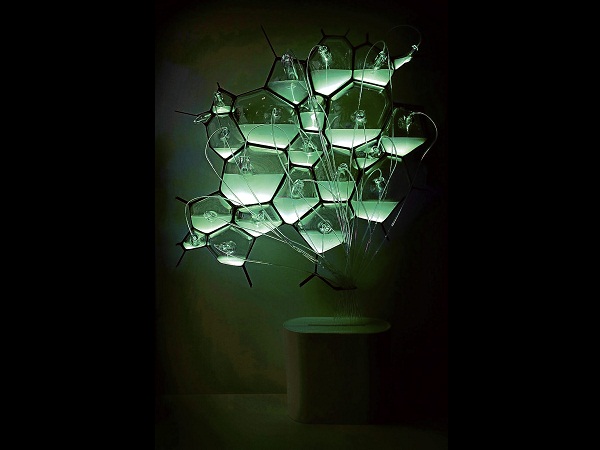
‘BIOLIGHT’ makes use of bioluminescent bacteria fed with methane gas and composted material. Glass cells hold the bacteria that emit a green glow, in this experiment by the Netherlands-based Philips Design and Lighting.
Sometime in 1999, I stumbled onto news of a new lighting system called “Colorkinetics.” It was an “intelligent” digital lighting technology developed by the US company of the same name, and it made use of “light emitting diodes” or “LED.” Apparently, LED wasn’t new technology then. Back in the ’70s, they were already being used in small electronic devices as indicator lighting. Its technology slowly developed from a low-tech, low-light device into the first-ever intelligent illumination system as built-on by the Colorkinetics’ cofounders. That was all of 13 years ago.
The modern day LED light as we know it today is digitally controlled and consumes very little energy. In all its multicolor glory, LED systems light the skyline of world’s big cities and is slowly replacing yesterday’s incandescent and fluorescent fixtures. Fortunately, their efficiency contributes a significant cost savings on power that we never expected new light technology could accomplish so soon.
Bioluminescence
But the more fortunate ones are the little creatures that exhibit the quality of “bioluminescence” or the ability to generate their own light. These organisms produce the enzyme luciferase, which interacts with a particular type of light-emitting molecule called a luciferin, and this combination produces light—much like a light stick where chemical compounds mix to produce a glow of light. It is a familiar concept to those who have gone night diving where plankton and jellyfish glow under the evening sky. Scientists say that approximately 90 percent of deep sea animals are bioluminous. On land, we have fireflies as the most popular bioluminescent creature.
The concept behind luminescence is very different from that of incandescence, where a lot of power is needed to create light. Because heat is hardly produced in the production of its light, bioluminescence has also become known as “cold light.”
What makes bioluminescence fascinating is that the animals themselves produce and use the light for attracting prey or fending off attackers. Essentially, for survival skills.
The Dutch lighting and design company, Philips, has begun exploring the possibilities of bioluminescence, and has produced an experimental “biolight.” “Biolight” makes use of bioluminescent bacteria fed with methane gas and composted material. In Philips’ experiment, the biolight was a part of a much larger system called a Microbial Home System, “a cyclical biological machine where wastes like sewage, effluent, garbage, wastewater are filtered, processed and recycled to be used as inputs for the various home functions.” In other words, it works as part of a zero-energy, zero-waste home.
Human waste
In the Philips model, glass cells hold the live bacterial culture that emits very soft green lighting when fed through silicon tubes from the food source. And what exactly is the methane food source? You guessed it: human waste.
But bioluminescent light, despite all the promise it holds, is limited to producing ambient lighting due to the low light emittance of the biological species. There are experimentations filling the cells with other fluorescent proteins that can magnify the bacteria’s light into a brighter light and make it more usable for other functions. But its development for practical use is still far-fetched. Biolight will probably be used where low light levels are needed as in exit signs, night-time road marks and signage, step lights for cinemas, theaters and other dark spaces, indicator lights, and even atmospheric lighting for therapy and mood-enhancement.
The biolight experiment could potentially create “living” energy products that are self-energizing, self-repairing and even self-reproducing. However, Philips claims that the current light model is not considered a prototype for a future light fixture but rather, a concept for discussion, conceptualization and experimentation. It opens up our thinking to unconventional light models. While the thought of lighting planet Earth with organic technology may still be remote, it’s a concept that may someday be made possible. Judging from how soon LED lights came into being, the future for bioluminescence may be closer than we think.
Contact the author through designdimensions@abi.ph or through our Asuncion Berenguer Facebook account.

